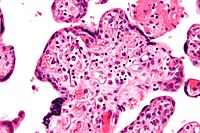
Photo from wikipedia
Abstract Fetal growth restriction (FGR) describes a fetus which has not achieved its genetic growth potential; it is closely linked to placental dysfunction and uteroplacental hypoxia. Estrogen-related receptor gamma (ESRRG)… Click to show full abstract
Abstract Fetal growth restriction (FGR) describes a fetus which has not achieved its genetic growth potential; it is closely linked to placental dysfunction and uteroplacental hypoxia. Estrogen-related receptor gamma (ESRRG) is regulated by hypoxia and is highly expressed in the placenta. We hypothesized ESRRG is a regulator of hypoxia-mediated placental dysfunction in FGR pregnancies. Placentas were collected from women delivering appropriate for gestational age (AGA; n = 14) or FGR (n = 14) infants. Placental explants (n = 15) from uncomplicated pregnancies were cultured for up to 4 days in 21% or 1% O2, or with 200 µM cobalt chloride (CoCl2), or treated with the ESRRG agonists DY131 under different oxygen concentrations. RT-PCR, Western blotting, and immunochemistry were used to assess mRNA and protein levels of ESRRG and its localization in placental tissue from FGR or AGA pregnancies, and in cultured placental explants. ESRRG mRNA and protein expression were significantly reduced in FGR placentas, as was mRNA expression of the downstream targets of ESRRG, hydroxysteroid 11-beta dehydrogenase 2 (HSD11B2), and cytochrome P-450 (CYP19A1.1). Hypoxia-inducible factor 1-alpha protein localized to the nuclei of the cytotrophoblasts and stromal cells in the explants exposed to CoCl2 or 1% O2. Both hypoxia and CoCl2 treatment decreased ESRRG and its downstream genes' mRNA expression, but not ESRRG protein expression. DY131 increased the expression of ESRRG signaling pathways and prevented abnormal cell turnover induced by hypoxia. These data show that placental ESRRG is hypoxia-sensitive and altered ESRRG-mediated signaling may contribute to hypoxia-induced placental dysfunction in FGR. Furthermore, DY131 could be used as a novel therapeutic approach for the treatment of placental dysfunction.
Journal Title: Biology of Reproduction
Year Published: 2022
Link to full text (if available)
Share on Social Media: Sign Up to like & get
recommendations!